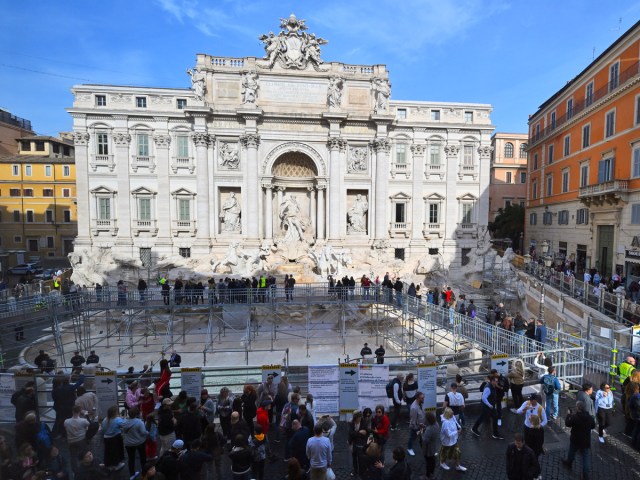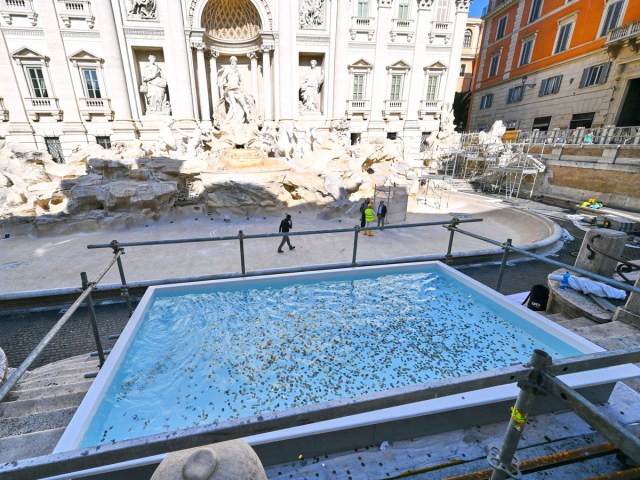In 2023, Rome had a record year for tourism, welcoming 35 million visitors. It’s easy to see why the Eternal City shows no signs of slowing down. Visitors remain as eager as ever to explore its centuries-old attractions steeped in history, and the Colosseum, the Pantheon, and the Roman Forum top many tourists’ bucket lists. But in 2024, city officials announced that one of Rome’s most iconic attractions, the Trevi Fountain, would be closing to undergo repairs. When it reopens, there’s a strong likelihood you won’t be able to see it for free anymore. Here’s why.
History of the Trevi Fountain

The Trevi is one of the world’s most famous fountains. Built in 1762, the baroque masterpiece was designed by Nicolo Salvi; after the architect’s death in 1751, Giuseppe Pannini oversaw the project’s completion. Standing 85 feet tall and 160 feet wide, the fountain — made out of Carrara marble — features a commanding statue of the god Oceanus riding a chariot pulled by seahorses and flanked by tritons. Even more remarkable is the fountain’s source: Its water is still supplied by the ancient Acqua Vergine aqueduct, a 12-mile-long structure built during the Roman Empire more than 2,000 years ago.
Why the Trevi Fountain Is So Popular

It’s not just the stunning architecture and impressive history that make the Trevi a Rome must-see. The fountain exploded in popularity after the 1954 film Three Coins in a Fountain, in which two of the lead characters throw coins into the waters of the Trevi. According to legend, doing so ensures the visitor will one day return to the Eternal City. The tradition has evolved somewhat over time — today visitors make any wish they’d like — but it’s more lucrative than ever. Local officials estimate that, each year, over a million euros’ worth of coins are tossed into the fountain, with the proceeds donated to a Catholic charity.
Major Renovations Underway

The year 2025 is a jubilee year for Vatican City, home to the headquarters of the Roman Catholic Church. The event is expected to draw over 30 million pilgrims and visitors not only to the Vatican — the world’s smallest country — but also to Rome, which entirely surrounds it. In preparation, city officials announced in 2024 that the Trevi Fountain would be closing to receive a much-needed cleaning. According to the website Artnet, the fountain hasn’t received a major renovation in over a decade, and the restoration is necessary to remove calcium buildup in the fountain. The project is estimated to cost over $300,000, but during the five-week process, visitors will be able to view the restoration work underway.
A Makeshift Replacement

Of course, just because the Trevi Fountain is empty doesn’t mean tourists will stop flocking to Rome. The city hoped to avoid the disappointment of those looking to partake in the famous coin-tossing tradition by setting up a makeshift replacement: According to CNN, the small pool installed in front of the fountain was primarily built to prevent workers from being hit with coins during the repair work. But the sight of a pool resembling an above-ground backyard pool in front of the iconic fountain drew scorn from some tourists, with CNN reporting that one visitor called it, “the saddest thing I’ve seen in Italy in as long as I can remember.”
“Concrete Possibility” To Charge an Entry Fee

Fortunately for tourists, the Trevi Fountain won’t be closed too long, but when it reopens, some visitors will be in for a surprise: Officials have floated a plan to charge admission to the iconic landmark. The entry fee would likely be modest — around one or two euros for nonresidents, according to reporting from USA Today — but more significantly, there would be a fixed number of daily entries and advance reservations required to visit.
Rome’s mayor shared with the paper that the measures are a “a very concrete possibility,” as “the situation at the Trevi Fountain is becoming technically very difficult to manage.” Considering Rome is expecting an even greater influx of visitors in 2025, the restrictions may be the only way to make the experience of viewing the fountain enjoyable for everyone.
Rome is far from the only city facing growing concerns about “overtourism.” Venice, its Italian neighbor to the north, recently introduced a daily tourist tax in an attempt to curb excess tourism, while Amsterdam — another booming European destination — announced a plan to curtail new hotel construction in the city.
More from our network
Daily Passport is part of Inbox Studio, which publishes content that uplifts, informs, and inspires.
















